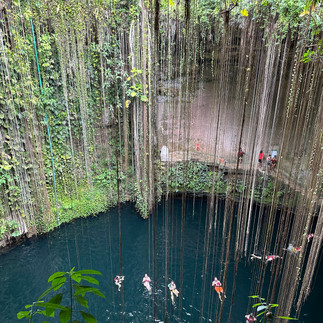Chichen Itza - Enchantment of Water
- Kelly Moretta

- Feb 17, 2023
- 3 min read

The Chichen Itza complex is one of the most spectacular Maya archeological sites to visit while in the Yucatan!
The complex is quite extensive and most areas can be visited. I highly advise going with a tour guide as you will likely need transportation to the complex from the hotel zones but also because a tour guide will give you the best overview of the culture, history, and heritage of the Maya.

Chichen Itza" means "At the mouth of the well of the Itza." This derives from chi', meaning "mouth" or "edge", and chʼen or chʼeʼen, meaning "well". Itzá is the name of an ethnic-lineage group that gained political and economic dominance of the northern peninsula. One possible translation for Itza is "enchanter (or enchantment) of the water," from its (itz), "sorcerer", and ha, "water" and it’s no surprise that this is a powerful spot for me as well as many others that visit this sacred site!
Chichen Itza is located in the eastern portion of the Yucatan in Mexico. The northern Yucatán Peninsula is Karst, and the rivers in the interior all run underground. There are four visible, natural sink holes, called Cenotes, that could have provided plentiful water year round at Chichen, making it attractive for settlement. Of these cenotes, the "Cenote Segrado" or "Sacred Cenote" (also variously known as the Sacred Well is the most famous.[ In 2015, scientists determined that there is a hidden Cenote under the Temple, which has never been seen by archeologists!

El Templo, known as the Temple of Kukulcán, is a pyramid that dominates the center of the Chichen Itza.
Built by the pre-columbian maya civilization sometime between the 8th and 12th centuries AD, the building served as a temple to the deity Kukulcán, the Yucatec Maya Feathered Serpent deity closely related to Quetzalcoatl.
I can’t begin to accurately share all of the cool facts about Chichen Itza, but I will geek out a bit on this aside from the water connection and Quetzacoatl who is one of my sacred guides.
The location of the temple within the site sits directly above a cenote, or water cave, and is aligned at the intersection between four other cenotes: the Sacred Cenote (North), Xtoloc (South), Kanjuyum (East), and Holtún (West).

This alignment supports the position of the Temple of Kukulcán as an axis mundi. The western and eastern sides of the temple are angled to the zenith sunset and nadir sunrise, which may correspond with other calendar events such as the start of the traditional planting and harvesting seasons as well as related ritual activities.
The temple is illuminated on the Spring and Fall Equinoxes so that the serpent seemingly comes alive. These events are attended by thousands to receive this powerful energy and witness the coming of light.
I highly recommend this tour for all that come to the area, especially those traveling a spiritual path or an awakening of their consciousness!
So down to the details!
Find a local tour guide for a day long multi-stop excursion! I highly recommend Mexico Kan Tours. While I did not travel with them personally to Chichen Itza on my two different excursions there, I have toured with them multiple times and find them to be premier tour guides with a sensitivity to our Mother Earth.
Mayan Collaborative Village where all work together as One in Unity to provide and enrich all including Mother Earth.
Dress for the weather! It is usually hot, somewhat dusty and very little shade will be found! Sunscreen, a hat, water, and camera are a must! There are umbrellas for rent in case of rain as we had this last trip or to shade yourself from the sun if you are very sensitive.
Most tours involve a stop for lunch and a cenote swim so a swimsuit and change or clothes are also recommended! Cash is a great idea as well for souvenirs.
A Cenote stop Near Chichen Itza
Do a little research if it calls to you before your trip! I’ve included some links below.
Bring a favorite crystal or two to receive the energy of this sacred site.
Pay attention in dreams and meditations prior to and following your visit. I have had some amazing blessings come through my connection to this ancient sacred site!
For those of you that are Earth Keepers and Grid Workers like me, or just love to connect to the land in new and different ways, I highly recommend one of my favorite artist's, Deya Dova. She travels the planetary grid working with the Earth and its elements, weaving and creating amazing light (language) music for all. This compilation is near and dear to my heart, soul and this land...
As always, my intention is to inspire, in-courage, and in-power you to live your best Awakened Soul Life!
Love and Blessings,
Kelly
Reference and Gratitude to:
Recommended Tour Guides:


























Comments